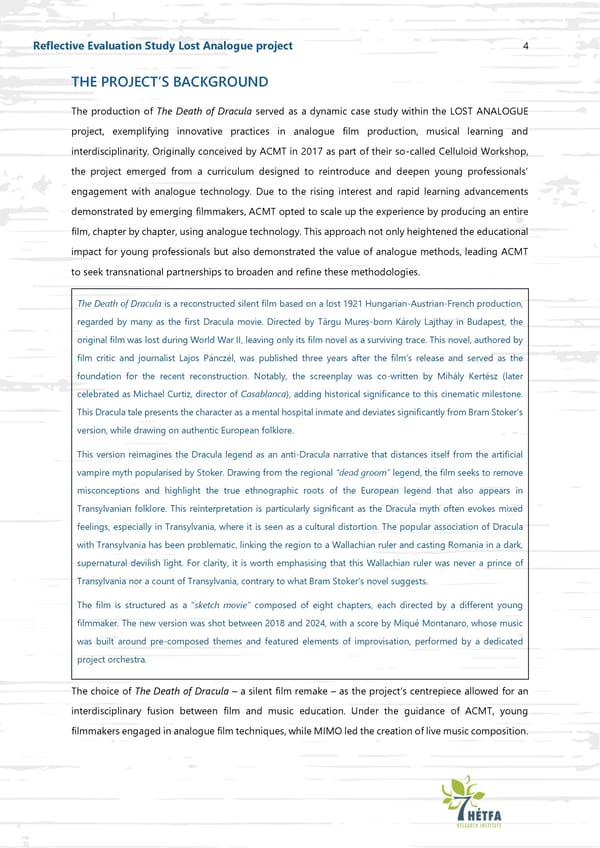4 Reflective Evaluation Study Lost Analogue project THE PROJECTS BACKGROUND The production of The Death of Dracula served as a dynamic case study within the LOST ANALOGUE project, exemplifying innovative practices in analogue film production, musical learning and interdisciplinarity. Originally conceived by ACMT in 2017 as part of their so - called Celluloid Workshop, t he project emerged from a curriculum designed to reintroduce and deepen young professionals engagement with analogue technology. Due to the rising interest and rapid learning advancements demonstrated by emerging filmmakers, ACMT opted to scale up the exp erience by producing an entire film, chapter by chapter, using analogue technology. This approach not only heightened the educational impact for young professionals but also demonstrated the value of analogue methods, leading ACMT to seek transnational par tnerships to broaden and refine these methodologies. The Death of Dracula is a reconstructed silent film based on a lost 1921 Hungarian - Austrian - French production, regarded by many as the first Dracula movie. Directed by Trgu Mure - born Kroly Lajthay in Budapest, the original film was lost during World War II, leaving only it s film novel as a surviving trace. This novel, authored by film critic and journalist Lajos Pnczl, was published three years after the films release and served as the foundation for the recent reconstruction. Notably, the screenplay was co - written by Mihly Kertsz (later celebrated as Michael Curtiz, director of Casablanca ), adding historical significance to this cinematic milestone. This Dracula tale presents the character as a mental hospital inmate and deviates significantly from Bram Stokers version, while drawing on authentic European folklore. This version reimagines the Dracula legend as an anti - Dracula narrative that distances itself from the artificial vampire myth popularised by Stoker. Drawing from the regional dead groom legend, the film seeks to remove misconceptions and highlight the true ethnographic roots of the European legend that also appears in Transylvanian folklore. This reinterpretation is particularly significant as the Dracula myth often evokes mixed feelings, especially in Transylvania, where it is seen as a cultural distort ion. The popular association of Dracula with Transylvania has been problematic, linking the region to a Wallachian ruler and casting Romania in a dark, supernatural devilish light. For clarity, it is worth emphasising that this Wallachian ruler was never a prince of Transylvania nor a count of Transylvania, contrary to what Bram Stokers novel suggests. The film is structured as a sketch movie composed of eight chapters, each directed by a different young filmmaker. The new version was shot between 2018 and 2024, with a score by Miqu Montanaro, whose music was built around pre - composed themes and featured elements of improvisation, performed b y a dedicated project orchestra. The choice of The Death of Dracula a silent film remake as the projects centrepiece allowed for an interdisciplinary fusion between film and music education. Under the guidance of ACMT, young filmmakers engaged in analogue film techniques, while MIMO led the creation of live music composition.
 Celluloid Connections: Cultivating creative skills through analogue film and musical collaboration Page 4 Page 6
Celluloid Connections: Cultivating creative skills through analogue film and musical collaboration Page 4 Page 6